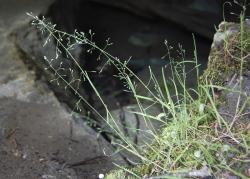- Taxon
- Gallery
- ≡ Poa imbecilla var. breviglumis (Hook.f.) Cheeseman, Man. New Zealand Fl., ed. 2, 201 (1925)
- = Poa breviglumis var. brockiei Zotov, Rec. Domin. Mus. 5: 131 (1965)
- = Poa breviglumis var. moarii Zotov, Rec. Domin. Mus. 5: 132 (1965)
Soft, weak, loosely tufted, stoloniferous or rhizomatous perennial, c. 5–40 cm, rooting at lower nodes, smaller tufts sometimes with close-packed shoots; leaves < culms, bright green, leaf-blades persistent; branching extravaginal near plant base, intravaginal above. Leaf-sheath light green, sometimes purplish, later very light brown, membranous, distinctly ribbed, glabrous. Ligule 0.5–1.5–(3) mm, entire, glabrous throughout. Leaf-blade c. 2–9 cm × 0.5–1.5 mm, flat, abaxially slightly scabrid near acute, ± incurved tip, slightly scabrid adaxially and on margins. Culm (3)–10–25–(35) cm, internodes glabrous. Panicle 3–10–(16) cm, lax and delicate; branches often paired, very fine, scabrid, spreading, bearing few spikelets, pedicels scabrid on angles, often purplish. Spikelets 2–3–(5) mm, 2–3–(5)-flowered, light green, often purple-tinged. Glumes usually noticeably unequal, often purplish, smooth; lower 0.3–0.8–(1) mm, 1-nerved, triangular, subacute, upper (0.8)–1–1.5 mm, 3-nerved, more ovate, subobtuse, rarely with a few prickle-teeth on midnerve; margins entire. Lemma 1.2–2 mm, 3-nerved, subobtuse, smooth apart from a few prickle-teeth on midnerve; margins entire, usually purplish towards tip. Palea 1.0–1.5 mm, keels smooth, or with a few prickle-teeth near tip, interkeel smooth. Callus glabrous. Rachilla c. 0.5 mm, glabrous. Lodicules c. 0.4 mm, rarely hair-tipped. Anthers 0.2–0.3 mm. Gynoecium: ovary 0.4 mm; stigma-styles 0.7–0.8 mm. Caryopsis 0.9–1 × 0.3–0.5 mm. 2n= 28.
[From: Edgar and Connor (2000) Flora of New Zealand. Volume 5 (second printing).]




